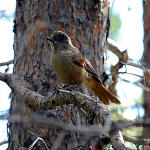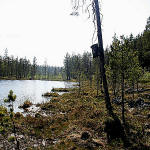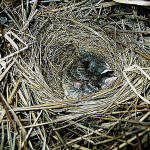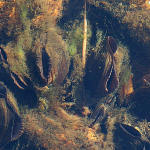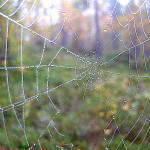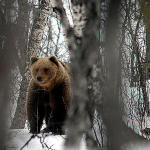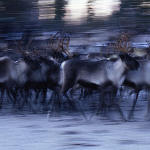

Home
Area
Vätsäri
Övre Pasvik
Pasvik Zapovednik
Nature
Geology
Climate
Water system
Flora
Fauna
Culture
Population
Religion
Sources of livelihood
Old ways of life
Time of industrialism
History
Stone Age
Early Metal Age
Late Metal Age
Middle Ages
Towards modern times
Timeline
Cooperation
Nature monitoring
Nature tourism
Publications
Contacts
Visit Pasvik-Inari
Guidelines
Regulations
News
Links
Fauna
The Pasvik-Inari area has a vital brown bear (Ursus arctos) population. The bear population is common for the three countries as the bears cross the national borders. One third of Norwegian bears live in Pasvik and the research of the species is centralised in Øvre Pasvik. The most abundant predators in the area are fox (Vulpes vulpes), stoat (Mustela erminea) and pine marten (Martes martes). Wolverine (Gulo gulo) is rare despite the protection. Before the Second World War, the wolf (Canis lupus) was common but today only some wandering individuals cross the area occasionally. Lynx (Lynx lynx) are also observed occasionally.
Wilderness pastured
Reindeer (Rangifer tarandus) economy is one of the main sources of livelihood in the north. The wilderness is a huge pasture. Approximately 6 000 reindeer pasture in the forests of Vätsäri and Øvre Pasvik. The herds pasture in different areas depending on the season and availability of food. A fence prevents the reindeer form wandering across the national borders. In Pasvik Zapovednik the reindeer are not allowed to pasture. However, some reindeer occasionally cross the Norwegian-Russian border to enjoy the lichen, but they are soon chased back to Norway. The Pasvik-Inari area has also a quite large elk (Alces alces) population.
A lake covered with feathers
The rich bird fauna is concentrated at the wetlands near Pasvik River. The core of the Pasvik Nature Reserve is Lake Fjærvann (Höyhenjärvi), the most untouched area of the river. The name of the area means "a lake covered with feathers", which describes well the shallow, lush lake teeming with bird life. The ice melts early in the spring and the lake freezes late in the autumn. This is an important resting place for a large number of migratory birds. Also nesting birds, such as ducks and waders, are abundant. In the early spring Goldeneyes (Bucephala clangula), Black Throated Divers (Gavia arctica) and Goosanders (Mergus merganser) start building their nests. Smews (Mergus albellus) are less abundant, and in Norway the Smews do not nest outside Pasvik. The Spotted Redshank (Tringa erythropus) nests in the forests but feeds on the shore of the Pasvik River. The most common inhabitant on the shores, Common Sandpiper (Actitis hypoleucos), is easily recognized by the swinging tail. On the bogs and on grass covered shores one can admire the silent displays of the Ruffs (Philomachus pugnax). A fortunate visitor may see an Osprey (Pandion haliaetus) dashing over the river.
The eastern inhabitants of the forests
Several eastern species nest in the forests near Pasvik River, for example the Siberian Tit (Parus cinctus), the Siberian Jay (Perisoreus infaustus) and the Waxwing (Bombycilla garrulus). The Pine Grosbeak (Pinicola enucleator), the Brambling (Fringilla montifringilla) and the Three-toed Woodpecker (Picoides tridactylus) are also common. The most abundant grouses are Capercaillie (Tetrao urogallus) and Willow Grouse (Lagopus lagopus). The most abundant owl is the Northern Hawk Owl (Surnia ulula), but in the forest covered areas also the rare Great Grey Owl (Strix nebulosa) nests. Abundance of many predators, such as the most typical bird of prey the Rough-legged Buzzard (Buteo lagopus) depends on the abundance of rodents. Rodent stocks vary periodically and if the rodents are few in number, the buzzards do not start nesting. Also the rare Great Grey Owl only nests in years with large amounts of rodents. Efforts are made in all three countries to find the nesting territories of the rare northern species, Golden Eagle (Aquila chrysaetos).
More and less visible invertebrates
Insects create a large group with many interesting species. A beautiful bluish dragonfly, the Azure Hawker (Aeshna caerulea), flying at a pond awakes attention. Various butterflies, such as blues (Polymmatinae) and ringlets (Erebia sp.), decorate the shore grasslands. Ant hills stand besides the paths in the pine forest. The northern taiga is famous for the abundance of the mosquitoes (Culicidae), black flies (Simuliidae) and biting midges (Ceratopogonidae). The annoyance is short in duration, however. Distribution of the freshwater pearly mussel (Margaritifera margaritifera) in the Pasvik catchment area has been studied recently. Several occurrences have been registered in Norwegian and Russian rivers and streams, whereas no mussels have been found in Finland.
